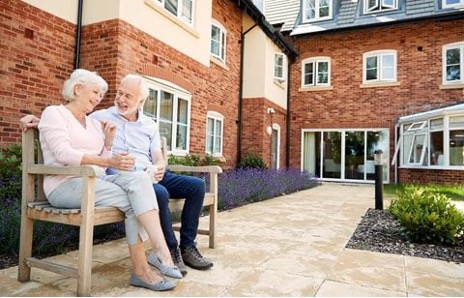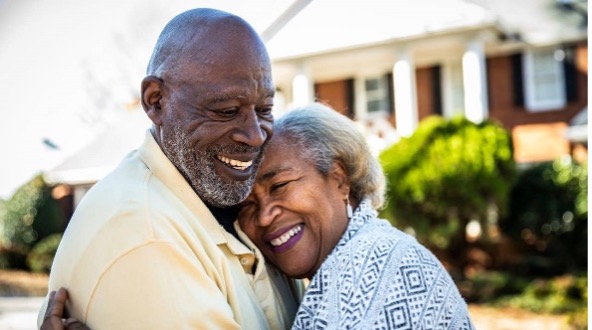The United States is experiencing a seismic demographic shift, often referred to as “The Silver Tsunami”, a rapid and unprecedented increase in the number of older adults. By 2034, for the first time in U.S. history, there will be more seniors over the age of 65 than children under 18. While longevity is a testament to medical and technological advancements, it also brings forth significant challenges, particularly in housing. Affordable housing for low-income seniors has become one of the most pressing social issues of our time.
Many seniors rely on fixed incomes, such as Social Security or modest pensions, yet they face rising housing costs, increasing property taxes, and escalating healthcare expenses. The financial strain is exacerbated by the fact that many older adults have not been active in the housing market for years, sometimes decades. leaving them vulnerable to predatory lending, rental scams, and the complexities of finding affordable housing options. For those who rent, the situation is even more dire: nearly 11 million seniors in the U.S. are cost-burdened, meaning they spend more than 30% of their income on housing, and half of these individuals spend over 50%.
The Affordable Housing Crunch for Seniors
The affordable housing crunch is not a new phenomenon, but it has intensified in recent years due to several converging factors. Housing costs in the U.S. have consistently outpaced income growth for the past three decades. For older homeowners, this may mean struggling with rising property taxes, home maintenance expenses, or even paying off lingering mortgages. However, for older renters, the challenges are even more pronounced. The lack of affordable rental options forces many seniors to make impossible choices: cutting back on food, skipping medications, or forgoing necessary medical care just to keep a roof over their heads.
A 2022 report by Harvard University’s Joint Center for Housing Studies found that nearly three-quarters of older renters earning under $15,000 annually are severely cost-burdened. In many cases, these seniors are just one financial setback away from homelessness. Some end up hospitalized for conditions aggravated by housing instability, while others are forced into nursing homes, not because they need full-time care, but because they have nowhere else to go.
Barriers to Affordable Housing for Seniors
Several barriers make it difficult for low-income seniors to access affordable housing:
- Limited Availability of Affordable Senior Housing: demand for low-income senior housing far exceeds supply, leading to years-long waiting lists for subsidized programs.
- Rising Housing Costs: Rent prices have steadily increased while federal resources for affordable housing programs have declined.
- Fixed Incomes and Financial Strain: With one in five seniors living one major financial event away from crisis, even minor increases in rent or property taxes can be devastating.
- Accessibility and Suitability: – Many seniors need age-friendly housing with features such as wheelchair accessibility, grab bars, and proximity to healthcare services, yet such options are scarce.
- Lack of Awareness and Assistance: Many seniors are unaware of available housing programs or struggle with the complex application processes needed to access them.
Why Addressing This Matters
Housing is more than just shelter, it is a fundamental determinant of health, dignity, and quality of life. Seniors who experience housing insecurity or homelessness face significantly higher risks of mental and physical health decline, social isolation, and premature mortality. Conversely, stable, affordable, and accessible housing can reduce hospitalizations, improve well-being, and promote independent living for as long as possible.

This article will explore the key challenges faced by low-income seniors in securing affordable housing, examine the role of government programs, and suggest alternative housing solutions that could help ensure that all seniors, regardless of income level, have a safe and stable place to call home.
The Growing Need for Affordable Senior Housing
Senior Housing News reported that the United States is experiencing a historic shift in its population demographics. The number of adults aged 65 and older has surged from 43 million in 2012 to 58 million in 2022; a staggering 34% increase. As the Baby Boomer generation continues to age, the demand for affordable senior housing is reaching unprecedented levels. With fixed incomes, increasing healthcare costs, and limited affordable housing options, many older adults face significant barriers to securing stable and suitable living environments.
The Economic Strain on Low-Income Seniors
For many seniors, housing costs consume an overwhelming portion of their limited financial resources. In 2021, 11.2 million older adults were cost-burdened, meaning they spent more than 30% of their income on housing. This marks a significant rise from 9.7 million in 2016. Even more concerning, over half of these households were severely cost-burdened, meaning they allocated more than 50% of their income to housing expenses.
While housing costs alone are a major hurdle, they are compounded by healthcare expenses, long-term care needs, and inflation. According to research from the Joint Center for Housing Studies of Harvard University, nearly three-quarters of adults over 65 will require some form of long-term care for an average of three years, with one in four needing care for five years or more. The cost of such care is often unaffordable: across 97 metro areas, only 13% of seniors could afford the median-priced assisted living facility, while just 14% could afford four-hour daily in-home care visits. These financial burdens make it nearly impossible for many older adults to secure housing that accommodates their evolving health needs.
The Impact of Housing Instability on Senior Health and Well-Being
Housing instability is more than just a financial issue. It directly affects seniors’ physical health, mental well-being, and overall quality of life. Research has shown that seniors who struggle to afford housing are at higher risk of chronic illness, mental distress, and premature mortality. Without stable housing, many older adults experience:
- Increased hospitalizations due to unsafe living conditions or an inability to afford proper nutrition and medication.
- Higher rates of depression and anxiety, especially among those who live alone or face eviction.
- Social isolation, which has been linked to cognitive decline, dementia, and other severe health consequences.
For the many vulnerable seniors, housing instability can mean homelessness or forced institutionalization. Many older adults end up in nursing homes not because they require medical care, but simply because they have nowhere else to live. This not only diminishes their independence but also places additional strain on public healthcare resources.
As the population of older adults continues to grow, the urgent need for affordable, accessible, and supportive housing options will only intensify. Without intervention, the financial strain on seniors, the healthcare system, and housing programs will reach crisis levels. The next section will explore programs providing support for affordable senior housing.
Government and Other Programs Supporting Affordable Senior Housing
For low-income seniors struggling with housing costs, various government programs, nonprofit initiatives, and community-based resources provide essential support. These programs aim to ensure that older adults have access to safe, stable, and affordable housing, helping them maintain their independence and quality of life. Understanding these programs is crucial for seniors, caregivers, and policymakers seeking solutions to the growing housing crisis.
HousingInfo.org has provided a summary of these programs:
Federal, State, and Local Housing Assistance Programs:
Property Tax Relief and Mortgage Assistance
For seniors who own their homes, rising property taxes and mortgage costs can pose significant financial burdens. Some states offer property tax deferral or exemption programs to help seniors reduce their tax liabilities. Additionally, federal foreclosure prevention programs, such as the Home Affordable Modification Program (HAMP) and the Home Affordable Refinance Program (HARP) (which expired in 2016 and 2018, respectively), once provided relief to cost-burdened homeowners, highlighting the need for renewed financial assistance programs for aging homeowners.
State and Local Senior Housing Initiatives:
Beyond federal programs, many state and local governments implement housing assistance initiatives for seniors. Some areas offer:
- Rent control measures, limiting how much landlords can increase rent for senior tenants.
- Tenant protections, requiring landlords to establish “just cause” for evictions.
- State-funded rental assistance programs, helping seniors bridge the affordability gap.
However, these protections are not widespread, and in many cases, rent control policies remain controversial, with concerns about discouraging new housing development.
Nonprofit and Community-Based Housing Assistance:
While government programs provide crucial support, nonprofit organizations and community-based initiatives also play a vital role in helping secure affordable housing for low-income seniors. These organizations provide subsidized housing, financial aid, and advocacy efforts to expand housing access.
Faith-Based and Local Community Housing Programs:
Churches, senior advocacy groups, and local nonprofits often provide emergency housing, rental assistance, and home repair programs for older adults in need. Many seniors turn to these organizations when they struggle to qualify for government assistance or face urgent housing needs.
Challenges and Gaps in Housing Assistance
Despite the existence of these programs, only about one-third of income-eligible seniors receive federal rental assistance, according to HUD. Long waiting lists, bureaucratic hurdles, and limited funding prevent many seniors from accessing housing support in time. Additionally, programs like Section 202 serve just 133,000 seniors nationwide, a fraction of those in need.
The growing demand for senior housing will require increased government funding, expansion of rental assistance programs, and more affordable senior housing developments. As more seniors face housing insecurity, innovative solutions, such as integrating healthcare with housing, expanding eviction protection, and incentivizing new senior housing construction, will be critical.
The next section will explore alternative housing solutions, including shared housing, accessory dwelling units (ADUs), and senior co-housing, which may offer sustainable options for older adults seeking affordable living arrangements.
Alternative Housing Solutions for Low-Income Seniors
As the aging population grows, so does the demand for innovative and affordable housing solutions that enable seniors to live with dignity, independence, and community support. Traditional housing models are often insufficient or too costly for low-income seniors, driving the need for alternative living arrangements. Shared housing, accessory dwelling units (ADUs), and senior co-housing are emerging as sustainable and effective options. These alternatives provide not only affordable living but also foster social connections and improve mental and physical well-being for older adults.
1. Shared Housing and Multigenerational Living
Shared housing is an arrangement where multiple generations live together, sharing common spaces such as kitchens, gardens, and recreational areas while maintaining private living quarters. This model promotes intergenerational support and reduces loneliness, which is particularly beneficial for seniors who are at greater risk of depression and social isolation.
In multigenerational cohousing, younger residents often assist with daily tasks, such as shopping or yard maintenance, while benefiting from the wisdom and companionship of older adults. This arrangement fosters a sense of community and purpose, enhancing the well-being of all age groups. Research shows that older adults living in multigenerational households experience improved mental health and greater life satisfaction compared to those living alone.
2. Home Sharing Programs
Home sharing involves an older adult renting out a spare room to another individual, often another senior or a younger person seeking affordable housing. This arrangement reduces living costs for both parties while providing companionship and increased security. It is particularly beneficial for widowed or divorced seniors, who might otherwise face social isolation.
Programs like the National Shared Housing Resource Center connect older adults with potential housemates, ensuring compatibility and safety through background checks and interviews. Research indicates that seniors who participate in home-sharing arrangements save between $500 and $700 per month on housing costs. Additionally, the companionship provided through home sharing has been linked to improved mental health and a lower risk of cognitive decline.
Accessory Dwelling Units (ADUs)
Accessory Dwelling Units (ADUs), commonly known as “granny flats” or “in-law suites” are small, independent living spaces built on the same property as a single-family home. ADUs allow seniors to live near family members while maintaining independence. They are particularly beneficial for aging parents who wish to remain close to their adult children without sacrificing privacy.
ADUs are gaining popularity as they offer:
- Cost-effective living: Building an ADU is often more affordable than moving to a retirement community or assisted living facility.
- Flexibility and Accessibility: ADUs can be customized with age-friendly features, such as wheelchair ramps, walk-in showers, and grab bars, making them suitable for aging in place.
- Intergenerational Support: By living nearby, families can provide support with daily tasks or caregiving while maintaining separate households.
Several states and municipalities are easing zoning restrictions to encourage the development of ADUs as a way to address the affordable housing crisis. For example, California and Oregon have implemented state laws to streamline ADU construction, recognizing their potential to provide affordable housing for seniors and others.
Senior Co-Housing and Cooperative Living
Senior Co-Housing
Senior co-housing communities are designed specifically for older adults who wish to live in socially connected environments while maintaining independent households. These communities emphasize shared resources and communal decision-making, reducing living expenses through shared utilities, maintenance, and amenities. Residents have their own private homes but share common areas such as dining rooms, gardens, and recreational spaces.

Co-housing communities foster social interactions, mutual support, and active lifestyles, which significantly reduce feelings of isolation and depression among seniors. They also provide opportunities for community-led caregiving, where neighbors assist each other with daily activities, delaying or eliminating the need for costly professional care services.
Cooperative Living Models
In cooperative housing, seniors purchase a share in a cooperative corporation that owns and manages the property, rather than owning individual units. This model offers reduced housing costs and collective decision-making, allowing residents to influence community policies and services. Senior housing cooperatives often provide:
- Affordable living expenses: Since cooperatives are not-for-profit organizations, residents benefit from lower costs.
- Community Engagement: Shared spaces and events promote socialization and active engagement.
- Long-term Stability: Residents have more security compared to renting, as they collectively own the property.
This model is gaining traction in the U.S. as a viable option for affordable senior living. Some cooperatives cater specifically to seniors, creating age-friendly communities with accessibility features and on-site services tailored to older adults’ needs.
The Benefits of Alternative Housing Solutions
These alternative housing solutions provide more than just affordable shelter; they enhance mental, physical, and social well-being by promoting community engagement, reducing isolation, and enabling aging in place. By diversifying the housing options available to seniors, these models also relieve pressure on traditional housing programs like Section 202 and Housing Choice Vouchers, which face high demand and limited supply.

As the demand for affordable senior housing continues to grow, policymakers and community planners should prioritize and expand support for these innovative solutions.
Conclusion
The acute shortage of affordable housing for low-income seniors presents a significant and growing challenge. As the population of older adults continues to rise, the demand for safe, stable, and affordable housing is becoming increasingly critical. This issue is compounded by fixed incomes, escalating healthcare costs, and limited housing options, creating a complex landscape that requires strategic solutions.
Addressing these challenges necessitates a more effective use of available resources, including government programs, community-based initiatives, and nonprofit efforts. Innovative approaches such as shared housing, Accessory Dwelling Units (ADUs), and senior co-housing provide sustainable alternatives that support independence, foster community connections, and enhance the well-being of older adults.
Implementing these solutions requires coordination and collaboration among policymakers, communities, nonprofits, and stakeholders. Adjustments to existing policies, targeted funding for senior housing programs, and greater awareness of available resources can contribute to more effective support systems for low-income seniors.
Understanding the landscape of affordable senior housing and the resources available is essential for navigating this issue. Those impacted by housing costs can benefit from exploring programs and organizations designed to assist older adults. A collective approach to utilizing resources more efficiently can help ensure that all seniors have access to housing that supports their financial and physical needs, promoting dignity, security, and independence as they age.
FAQs*
*HousingInfo.org. https://housinginfo.org/affordable-housing-programs/affordable-housing-solutions-for-low-income-seniors
References
- NLC National League of Cities, Housing for Older Adults
https://www.nlc.org/article/2023/11/15/housing-for-older-adults/ - Affordable Housing Solutions for Low-Income Seniors: Navigating the Challenges. https://housinginfo.org/affordable-housing-programs/affordable-housing-solutions-for-low-income-seniors
- Affordable Housing Options for Low-Income Older Adults. ElderLaw Answers. https://www.elderlawanswers.com/affordable-housing-options-for-low-income-older-adults-19663
- Housing Affordability and Security Issues Facing Older Adults in the United States
Fenelon,A., Mawhorter, A. . https://pmc.ncbi.nlm.nih.gov/articles/PMC7799385/ - Senior Housing News. Christman, A. Baby Boomers Face ‘Urgent Need’ for More Affordable Senior Housing Options. https://seniorhousingnews.com/2023/11/30/baby-boomers-face-urgent-need-for-more-affordable-senior-housing-options/
- EDGE,PD&R / HUD.GOV. Understanding and Addressing the Housing Needs of Older Adults. https://archives.huduser.gov/PORTAL/pdredge/pdr-edge-featd-article-120324.html
- Housing With Hope. The 5 Biggest Challenges Facing American Seniors Today. May 18, 2023.
https://housingwithhope.org/the-5-biggest-challenges-facing-american-seniors-today/








